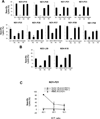Targeting human B-cell malignancies through Ig light chain-specific cytotoxic T lymphocytes
- PMID: 21813633
- PMCID: PMC3176952
- DOI: 10.1158/1078-0432.CCR-11-0970
Targeting human B-cell malignancies through Ig light chain-specific cytotoxic T lymphocytes
Abstract
Purpose: The variable regions of Ig (idiotype, Id) expressed by malignant B cells can be used as tumor-specific antigens that induce humoral and cellular immunity. However, epitopes derived from Id that stimulate human CD8(+) T-cell immunity are incompletely characterized.
Experimental design: The clonal Ig V(L) of human myeloma cell line U266 and five primary B-cell tumors were sequenced, and peptides corresponding to the Ig V(L) region were tested for their ability to stimulate CTLs from 10 HLA-A*0201-positive normal donors. The CTLs thus generated were tested against peptide-pulsed T2 cells and autologous tumor cells.
Results: Fourteen peptides derived from Ig light chain (V(L)) of U266 and primary B-cell tumors were used to generate 68 CTLs lines that specifically produced IFN-γ when cocultured with peptide-pulsed T2 cells. These CTLs lysed peptide-pulsed T2 cell as well as U266 or autologous tumor targets in an HLA class I-dependent manner. Sequence analysis revealed shared V(L) T-cell epitopes in U266 and primary B-cell tumors, not previously reported within Ig heavy chain (V(H)) sequences.
Conclusion: This study thus identifies novel immunogenic CTLs epitopes from Id V(L), suggests that they are naturally presented on the surface of B-cell malignancies, and supports their inclusion in next-generation Id vaccines. The ability to prime T cells derived from normal HLA-matched donors, rather than patients, may also have direct application to current strategies, designed to generate allogeneic tumor-specific T cells for adoptive transfer.
Figures




Similar articles
-
Idiotype-specific cytotoxic T lymphocytes in multiple myeloma: evidence for their capacity to lyse autologous primary tumor cells.Blood. 2001 Mar 15;97(6):1750-5. doi: 10.1182/blood.v97.6.1750. Blood. 2001. PMID: 11238117
-
Cytotoxic T cell responses against immunoglobulin in malignant and normal B cells: implications for tumor immunity and autoimmunity.Curr Pharm Des. 2003;9(23):1889-903. doi: 10.2174/1381612033454333. Curr Pharm Des. 2003. PMID: 12871193 Review.
-
Targeting heat shock proteins for immunotherapy in multiple myeloma: generation of myeloma-specific CTLs using dendritic cells pulsed with tumor-derived gp96.Clin Cancer Res. 2005 Dec 15;11(24 Pt 1):8808-15. doi: 10.1158/1078-0432.CCR-05-1553. Clin Cancer Res. 2005. PMID: 16361569
-
Generation of cytotoxic T lymphocytes specific for B-cell acute lymphoblastic leukemia family-shared peptides derived from immunoglobulin heavy chain framework region.Chin Med J (Engl). 2007 Apr 20;120(8):652-7. Chin Med J (Engl). 2007. PMID: 17517179
-
Identification of human idiotype-specific T cells in lymphoma and myeloma.Curr Top Microbiol Immunol. 2011;344:193-210. doi: 10.1007/82_2010_70. Curr Top Microbiol Immunol. 2011. PMID: 20549471 Review.
Cited by
-
IL-15 enhances the antitumor effect of human antigen-specific CD8+ T cells by cellular senescence delay.Oncoimmunology. 2016 Oct 7;5(12):e1237327. doi: 10.1080/2162402X.2016.1237327. eCollection 2016. Oncoimmunology. 2016. PMID: 28123872 Free PMC article.
-
Towards an off-the-shelf vaccine therapy targeting shared B-cell tumor idiotypes.Am J Blood Res. 2014 Dec 15;4(2):46-52. eCollection 2014. Am J Blood Res. 2014. PMID: 25755905 Free PMC article. Review.
-
Targeting B-cell malignancies through human B-cell receptor specific CD4+ T cells.Oncoimmunology. 2016 Sep 19;5(11):e1232220. doi: 10.1080/2162402X.2016.1232220. eCollection 2016. Oncoimmunology. 2016. PMID: 27999743 Free PMC article.
-
Successes, failures and new perspectives of idiotypic vaccination for B-cell non-Hodgkin lymphomas.Hum Vaccin Immunother. 2013 May;9(5):1078-83. doi: 10.4161/hv.23970. Epub 2013 Feb 13. Hum Vaccin Immunother. 2013. PMID: 23406835 Free PMC article. Review.
-
Complementation of antigen-presenting cells to generate T lymphocytes with broad target specificity.J Immunother. 2014 May;37(4):193-203. doi: 10.1097/CJI.0000000000000014. J Immunother. 2014. PMID: 24714353 Free PMC article.
References
-
- Kwak LW. Induction of immune responses in patients with B-cell lymphoma against the surface-immunoglobulin idiotype expressed by their tumors. N Engl J Med. 1992;327:1209–1215. - PubMed
-
- Bendandi M, Gocke CD, Kobrin CB, Benko FA, Sternas LA, Pennington R, et al. Complete molecular remissions induced by patient-specific vaccination plus granulocyte-monocyte colony-stimulating factor against lymphoma. Nat Med. 1999 Oct;5(10):1171–1177. - PubMed
-
- Neelapu SS, Kwak LW, Kobrin CB, Reynolds CW, Janik JE, Dunleavy K, et al. Vaccine-induced tumor-specific immunity despite severe B-cell depletion in mantle cell lymphoma. Nat Med. 2005;11(9):986–991. - PubMed
-
- Li Y, Bendandi M, Deng Y, Dunbar C, Munshi N, Jagannath S, et al. Tumor-specific recognition of human myeloma cells by idiotype-induced CD8+ T cells. Blood. 2000 October 15;96(8):2828–2833. 2000. - PubMed
Publication types
MeSH terms
Substances
Grants and funding
LinkOut - more resources
Full Text Sources
Other Literature Sources
Medical
Research Materials

